The 5 Most Notorious Money-Laundering Cases of All Time
 Money laundering is the process by which criminals make their ill-gotten profits appear legitimate. They usually do this by funneling the cash through one or more wholesome-seeming and low-profile businesses — ranches, restaurants and amusement parks are popular choices. By moving money around from one bank account to the next and by channeling it into businesses, drug traffickers, embezzlers, mobsters, con artists and other criminal types are able to camouflage the money’s origins — at least, to a point.
Money laundering is the process by which criminals make their ill-gotten profits appear legitimate. They usually do this by funneling the cash through one or more wholesome-seeming and low-profile businesses — ranches, restaurants and amusement parks are popular choices. By moving money around from one bank account to the next and by channeling it into businesses, drug traffickers, embezzlers, mobsters, con artists and other criminal types are able to camouflage the money’s origins — at least, to a point.
When you go to school online to earn your financial crimes investigator certificate, you’ll learn all about the lengths to which criminals go to launder money. You’ll probably also study the work of some of these notorious money-laundering criminals from history.
Al Capone
Al Capone is quite possibly the most famous mobster who ever lived, and may have even provided the inspiration for the term “money laundering.” That’s because Capone laundered his $1 billion in Mob profits through a series of laundromats. The cash-only nature of these businesses made it easy for Capone to hide the nefarious source of his income, which he earned through bootlegging, gambling and prostitution. Despite founding one of the nation’s largest crime syndicates, Capone was eventually arrested for tax evasion and served seven years in Alcatraz.
The Island of Nauru
That’s right — an entire Pacific island was once implicated in a money laundering scheme. The island of Nauru can be found about 1,200 miles east of New Guinea in the middle of the Pacific Ocean on the south side of the Equator. Unlike some Pacific Islands you could mention, Nauru doesn’t have many marketable resources. Perhaps that’s why, in the 1990s, it found itself at the center of a $70 billion money-laundering enterprise.
Nauru’s laws at the time allowed banks to operate without a physical location on the island or elsewhere and, crucially, without recording the identities of depositors or keeping a paper trail of deposits and withdrawals. Russian gangsters took advantage of these fast and loose regulations to wash the stench of crime from their funds in Nauru’s “shell banks.” The scheme was eventually discovered, and Nauru accepted financial aid from Australia in return for a promise to change its ways.
King Leopold II of Belgium
In 1885, King Leopold II of Belgium was granted the privilege of protecting the Congo Free State — what is now the Democratic Republic of Congo — on the condition that he was to help its people achieve the comforts of a modern lifestyle and help it forge free trade relations with whatever nations it pleased. Instead, Leopold decided to spend the next 22 years diverting the nation’s entire GDP into his own coffers.
At this time, Congo was the single largest producer of rubber in the world. Leopold II embezzled the profits of the fledgling nation’s rubber production through several trading companies which he owned himself. In order to hide his activities, he closed the nation’s borders. By the time the Belgian government had wrested control of the Congo Free State from Leopold in 1907, its population had dropped by half.
Ferdinand Marcos
Ferdinand Marcos served as the President of the Philippines from 1965 to 1986, when a popular revolt ousted him from office. During that time, he embezzled $5 to $10 billion in public funds, which he laundered through banks in the U.S. and Switzerland, among other places. His wife, Imelda, is famous in her own right for ditching more than 2,500 pairs of shoes when she fled Manila with her husband during the uprising. Marcos died in exile in Hawaii before he could be brought to trial.
Pablo Escobar
Famously declared the 7th richest man in the world by Forbes in 1989, Pablo Escobar is said to have earned so much money through his drug cartel that he had to store most of the cash in warehouses, because he had more than he could put in banks. He is said to have controlled 80 percent of the world’s cocaine supply, and is rumored to have spent $1,000 a week just to buy the rubber bands he needed to wrap up his stacks of loot. Warehouses full of cash or not, Escobar embezzled $5 to $10 billion during his career before his life ended during a shoot-out with Columbian law enforcement in 1993.
If the stories of these infamous criminals make one thing clear, it’s that sometimes crime does pay very well — and that’s a problem for criminals who need to evade capture by hiding the source of their income. Money laundering is a big business but usually creates a disastrous end for the most successful in the field.
Al Capone image by U.S. Department of Justice from Wikimedia Commons.
King Leopold II image by Carolus from Wikimedia Commons.

Category: Law





